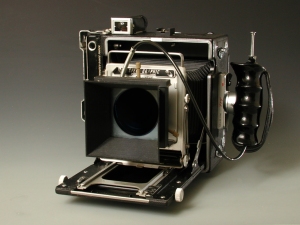Finding the Universal Lens-shade...
It may sound easy, just google for Linhof shade or search under Linhof at Ebay et Voilà.
In real life it is a little more complicated. There is just one "Universal" Lens-shade from Linhof. This is the very last model from around '68 or so, however these are discontinued also.
The only real "Universal" shade has a Ø 70mm with a reducing ring for 61mm.
Earlier universal lens shades came with the following sizes: Ø 42mm/32 - Ø 51mm/42 - Ø 60mm./51 NOTE: The hood of the 42mm is significantly smaller than the other ones and can be used only for 42 and 32mm.
The Linhof lens-shade basically consist of two parts i.e the hood and the filter adapter with slot for slip-in filters. If you're not using filters remember to slide a blank filter holder in to prevent light entering through the filter slot!
This type can be recognized by the lever to clamp the shade on the lens.
Reducing rings were available for 61mm, 51mm and 42mm. The hoods accept the 70mm slip-in filters.
The reducing rings for these latest shades are different from the earlier "Universal" shade. The earlier types had a red dot on it and it should be inserted with the red dots aligned. Later type does not have this dot...
Be aware there were different types during the years as well as different diameters. See below to get familiar with these types.
|
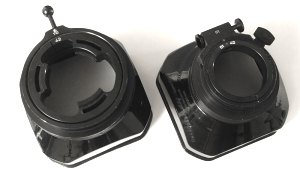
| |
On the left in the image is the real universal Linhof Lens-shade (Can be mounted on lenses from 32-70mm Ø)
On the right the 51mm, both hoods have the same size but adapters are different. Both shades can be seen with reducing rings for 42mm.
However slip-in filters differ also, as the latest model took 70mm slip-in filters the 51mm can take only 51mm slip-in filters.
Note also the difference in fastening the shade. The latest model uses a lever where the older model uses a push-type button.
|
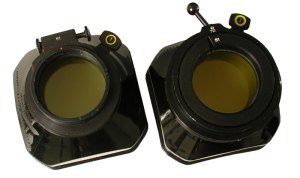
| |
Comparison of the two types: Both 51mm but using different size filters.
Note also the difference in the clamping devices! The 51mm lens-shade can be used also for 42mm diameter lenses with the correct reducing ring somewhere out there...but be sure it is the one with the red dot as the other one won't fit..
Advantage of this 51mm lens-shade is its smaller filter size instead of the more expensive 70mm filters.(I'm purposely not mentioning the Polaroid filter....)
|
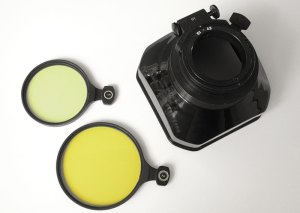
| |
Once more the 51mm lens-shade with the smaller (51mm dia) and the larger 70mm slip-in filter.
Note also the 42mm reducing ring with the two red dots aligned.
|
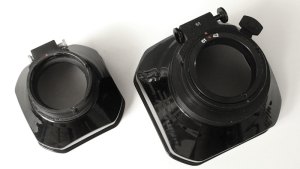
| |
Making it all a little more confusing:
Showing 2 posibilities to use on a lens with a diameter of 42mm.
There were also two more lens-shades - one 42mm with reducing ring 32mm (accepting only 42mm slip-in filters) and a 61mm (not shown) lens-shade with reducing ring to 51 and 42mm and accepting only 70mm slip-in filters.
|
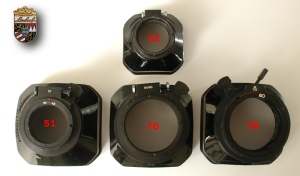
| |
All together...
- Shown on top - Universal Lens-shade 42mm (32mm reducing ring) Filter size 42mm
- On the far left - Universal Lens-shade 51mm (42mm reducing ring)Filter size 51mm
- Middle - Universal Lens-shade 61mm (51/42mm reducing ring) Filter size 70mm
- On the far right - Universal Lens-shade 70mm (61/51/42mm reducing ring)Filter size 70mm
Latest model...Also exists with the push button (elder type)
|

| |
Schematic view...
View of the latest Linhof Universal lens-shade.
Note the reducing rings differ from the earlier types. They don't have the red dot engraved. Both rings are not interchangeable!
Lever grip comes as shown with the letters "off" or replaced by a circular ball knob without inscription.
|
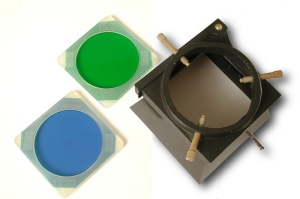
| |
Deciding for the Kodak Pathé's porte-filtre Professionnel No.2 to use the necessary filters?
Showing the hood and filter adapter and gelatine filter mounts.
Very universal though a little less sophisticated than the Linhof - shade.
|

|
|
Pacemaker Speed Graphic with Kodak Pathé's porte-filtre Professionnel No.2 and green gelatine filter
Originally designed for photographic use, Kodak’s WRATTEN filters have also become a popular choice for a wide variety of industrial applications.
These filters are manufactured by dissolving organic dyes in a gelatin material to achieve the desired spectral performance.
The gelatin liquid and dye combination is then coated onto a supportive substrate and dried. After removal from the substrate,
the film is coated with laquer for protection. Although the filters are coated, they should be handled only by the edges or
in the corners to avoid damage. Please note that storage in humid environments can cause the filters to cloud and temperatures
should not exceed 50°C for extended periods. |

| |
Pacemaker Speed Graphic with Kodak Pathé's porte-filtre Professionnel No.2 and blue gelatine filter
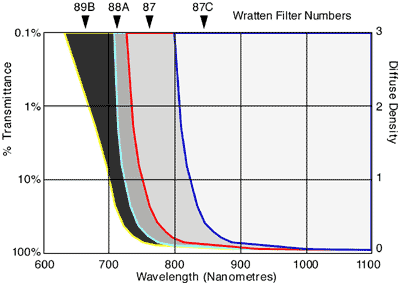
|

Back to filter section.




 Legal!
Legal!
 About
About
 Whois
Whois
 Aldis
Aldis
 Aero Project
Aero Project
 The Workout
The Workout
 Memorandum
Memorandum
 Encounter...
Encounter...
 Graflens
Graflens
 Lenses+
Lenses+
 Holes+
Holes+
 My Pacemaker SG's
My Pacemaker SG's
 Books
Books
 Graflinks
Graflinks
 Speedlights
Speedlights
 Gallery
Gallery
 WICF
WICF
 Contact
Contact
 Filmholders
Filmholders
 Start Page
Start Page
 Whatsnew
Whatsnew







